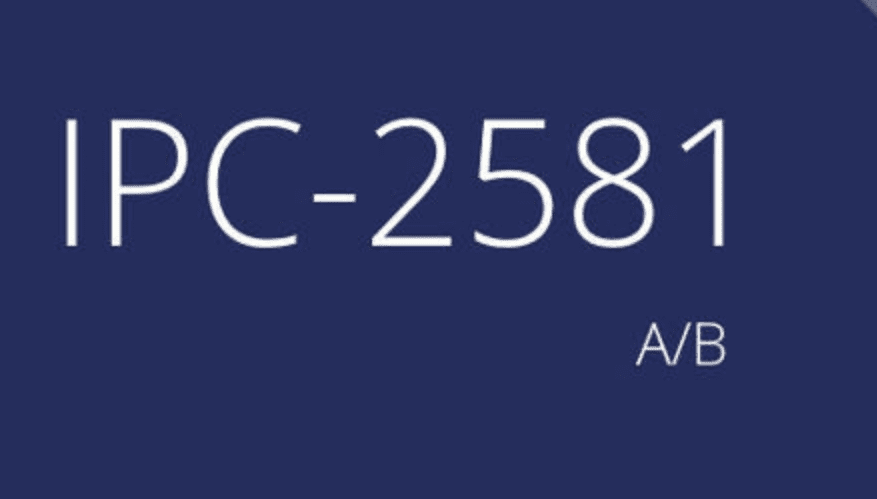One of several Application Characteristic Data specifications in the IPC 25XX Set of Data Exchange Specifications of the IPC specifications in the electronics sector is IPC-2581, often known as Digital Product Model or IPC-DPMX Digital. This innovative layered and balanced data format offers greater manufacturability, dependability, quality, and consistency for the data transmission from a manufacturing and assembly unit and a PCB designer. It is developed by a team of CAD and CAM users, tool developers, and standards developers.
IPC-2581 was developed to enable data exchange between PCB designers and manufacturers. IPC created it in 2004.IPC-2581 establishes recommendations for each step in the process flow to assist businesses in ensuring superior electronics assemblies manufactured for their products are superior in terms of manufacturability, quality, dependability, and consistency. The idea is comparable to that of a Gerber file.

However, there is more to what IPC-2581 means. In this article, you’ll understand other IPC-2581 features, such as the IPC-2581 consortium, its newest version, and its importance to engineers. But first, what exactly is the IPC-2581 consortium?
What Does IPC-2581 Consortium Mean?
There are various PCB supply chain and design businesses in the IPC-2581 consortium. The IPC 2581 consortium’s primary objective is to enable, encourage, and advance IPC-2581 application in the sector. Additionally, this consortium wants to make it easier for IPC-2581 to be implemented as a neutral and open standard to encourage innovation, boost productivity, and cut costs.
The assembly and production of PCBs are made easier by the IPC-2581 standard. Additionally, it will enable the direct download of design data into CAM systems. Therefore, compared to Gerber projects, this will save work and time. Additionally, the IPC-2581 consortium has more than 100 members, with participating businesses from various CAM, assembly, and PCB manufacturing.
A data interchange standard for various industries, including telecom, aerospace, and automotive, is the shared objective of all these businesses. A consortium member claims this standard’s vision extends to the manufacturing floor and the machines used.
The IPC-2581 standard is also universally owned. As a result, anyone can adopt this standard. This is a key factor in why it’s open. This standard was created in 2004 by the IPC consortium to fuse ODD++X with GenCam.
However, a new, updated version of the IPC-2581, the IPC-2581 C, was introduced in December 2020. This new version has more new but fantastic features.
IPC-258C – The New Version
IPC-2581C is the much-awaited upgrade to IPC’s widely embraced worldwide standard for design process via a manufacturing data flow called The Data and Transfer Methodology. With its new ground-breaking features and automation supporting bidirectional DFX intelligence power and Industry 4.0, Revision C does away with the time-consuming processes between manufacturers and design houses required before production can start.
The IPC-2581 expert group introduced support for the newest technologies, representing every facet of contemporary PCB design, as industry technology advances, including the most recent additive techniques with integrated components.
These updates include embedded components, rigid-flex, coins, cavities, connector ports, attenuation parameters, edge plating, pin polarities, intended net-shorts, countersink/counterbore, and square drill.

IPC-2581, which ensures that all relevant information is made into digital format, is the preferred approach for automating communication between manufacturing and design, far outpacing legacy and proprietary formats.
This bi-directional DFX data flow between manufacturing and design, which enables feedback to be sent and monitored before production starts, is a particular highlight of revision C. IPC-2581 revision C satisfies the demand for a collective, practical exchange for DFM issues, doing away with PowerPoints, spreadsheets, and emails and speeding up the launch of new products for clients.
Reasons IPC-2581 Is Vital for Engineers
The IPC 2581 structure protects data privacy, minimizes prolonged processes between individuals and PCB producers, lessens the production of several files for PCB fabrication, assembling, and testing, and lessens the likelihood of design error and misunderstanding.
The IPC-2581 provides engineers with these benefits:
● IPC-2518 addresses DFM issues
IPC-2518 has bidirectional DFX intelligence capabilities, which tackle the DFM interaction issue, and automation that supports Industry 4.0. Additionally, it lessens information omissions and communication barriers between different parties, including designers, PCB assembly firms, and PCB manufacturers, considerably increasing job productivity and cutting expenses.
To support and apply IPC-2581, NexPCB is now conducting research in this area. When the time comes, IPC-2581 support systems will be introduced. Therefore, every reliable electronics manufacturer ought to follow suit.
● It reduces miscommunication risks.
Engineers have a better way to integrate PCB designs with the IPC 2581. Additionally, experts from the manufacturing industry integrate PCB designs like netlists and pick-and-place coordinates. That reduces the chance of miscommunication.
● Flexibility
The IPC-2581 specification now includes a full supply chain and more participants. This supply chain includes PCB assembly, EDA software, and mechanical design solutions.
● CAM convenience and PCB design
Nearly all that engineers require is in the IPC 2581 file. The information required for PCB manufacture, assembly, and testing is also included in this standard. Furthermore, when the PCB design includes the buried/blind vias and pick-and-place coordinates, the IPC 2581 format will no longer require drill files.

● Less economic risk
The IPC-2581 lowers the economic risks. Engineers using small models for PCB construction, testing, and drilling will keep their circuit when they update it. Additionally, engineers don’t need to be concerned about DFM/CAM’s negligence.
● Data security
The PCB design cannot be changed using the Gerber file. That is because IPC-2581 includes all smart data, which could raise concerns about a possible data breach. Firms can send only the data pile to PCB designers using the IPC-2581 format.
Bottom Line
Every change is met with resistance, but because earlier standards have historically been difficult to communicate with, IPC-2581 has generally responded positively. PCB designers strongly prefer the IPC-2581 because it offers more advantages than the Gerber file standard.

The shift to this standard takes time, even when the advantages are clear. Nevertheless, some cutting-edge PCB software creators are combining the two forms. This helps you to pick the ideal option for your design.
Comments are closed